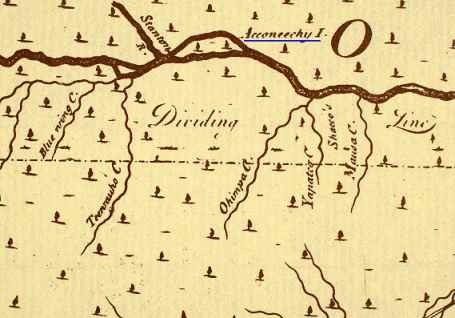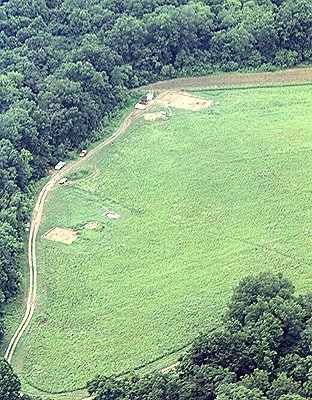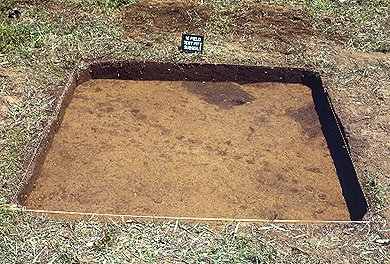
showing Occaneechi Island on Roanoke River.
From Excavating Occaneechi Town.
| The Journal for MultiMediaHistory Volume 1 Number 1 ~ Fall 1998 |
Excavating Occaneechi Town: Archaeology of an Eighteenth-Century Indian Village in North Carolina. R. P. Stephen Davis Jr., Patrick C. Livingood, H. Trawick Ward, and Vincas P. Steponaitis, eds. Chapel Hill, North Carolina: University of North Carolina Press. 1998. CD-ROM. PC, Windows 3.1 or Windows 95. [For more information and CD-ROM excerpts, go to: http://sunsite.unc.edu/uncpress/occaneechi.]
 |
showing Occaneechi Island on Roanoke River. From Excavating Occaneechi Town. |
Occaneechi Town was a seventeenth-century palisaded village with about a dozen house structures and associated features. Its site is located on an island in the Roanoke River northwest of modern Durham, North Carolina. The Occaneechis were Siouan-speaking people, living in the Carolina Piedmont amongst a variety of other Native American societies. The site of the town, called the "Fredricks" site by archaeologists, was discovered in 1983. Major excavations took place from 1984 through 1986.
The main menu offers ten options, including a twenty-five-page primer on the basics of archaeological excavation and a table of contents. There is a basic introduction to the CD-ROM format, including an annotated version of the table of contents. One can jump easily via hyperlinks from highlighted keywords in this section to specific subjects elsewhere. This is valuable whether one wishes to look at a specific artifact, a specific feature, or a specific published source in the bibliography. Another section provides cultural background on the original inhabitants of Occaneechi Town, a history of archaeological discovery and research, and other useful contextual information.
 |
From Excavating Occaneechi Town |
One is struck by the many ways in which this CD-ROM publication is better than a traditional printed monograph on the same subject would have been. There are over 4,000 full-color photos and maps. There are data on over 100,000 artifacts. All of this can be installed in either a complete version for professionals or in an abridged version for instructional or public use. The main difference is that human burials are omitted from the abridged version. Of course a great advantage of publication in CD-ROM format is that the path one takes through the many dimensions of an archaeological excavation is determined by the user, rather than by the authors. Even if one sets aside the advantages of interactivity and the version options, the cost of publishing something equivalent in book format would be prohibitively high.
One can browse through the excavations, zooming in on over 160 excavation units, most of them 10 x 10 foot squares. One can also zoom in on either structures or features, browse through linked photos and maps, or jump to artifact lists. Artifacts are dealt with in separate sections on pottery, stone tools, shell ornaments, and European trade artifacts. There are over 17,000 in the last category, arranged in about a dozen categories. Very helpful color images are provided for the most informative specimens, and these can be easily sent to a printer. Faunal remains are analyzed and there are some comparative data from the Wall site, which was once suspected of being the real Occaneechi Town.
The CD is technically superb. The software is written to support a graphics mode of 640 x 480 pixels. Images thus appear smaller on my screen and on those of others running in higher resolution modes. The "Read Me" file contains advice on how to get around interference with the Windows 95 Taskbar and other specific problems that will be encountered by some users. The authors have also anticipated many other questions with helpful advice in the "Read Me" file. Most users will not find it necessary to resort to these hints. As in any good software of this kind, there are many routes to the same ends and the cues are very clear to anyone with a working knowledge of written English. The graphics are very clear and the prose is unencumbered by fashionable obfuscation.
Educators will be delighted by the "Electronic Dig." Students should read the "Archaeology Primer" first, then move on to the "Electronic Dig Tutorial." One can restrict students by budgetary constraints in an electronic excavation simulation, using a modified command line. Occaneechi Town was completely excavated, and it is both educational and entertaining to see what happens if one has to make inferences on the basis of an excavation of only a portion of the site. Students can choose from an array of excavation strategies and take the interpretive consequences.
 |
From Excavating Occaneechi Town |
I only wish that the excavators of Fredricks site had used the metric system. The CD-ROM would be much more useful to American archaeologists in the future and to the rest of the world right now if it were unburdened by the quaintly provincial British system of weights and measures that even the British do not find useful anymore. Partial abandonment of this anachronism only makes things worse. Bone weights are given in grams while estimated meat yields are given in pounds.
I am going to install my review copy of the CD-ROM on our departmental server (to be available to only one user at a time, of course), and I am hopeful that other institutions will do the same. I also hope that universities in other countries do the same, but asking non-American students to cope with feet and inches might discourage its use.
Excavating Occaneechi Town is an electronic publication worth imitating. Its hardware requirements are modest (486/66 or faster processor, Windows 3.1 or higher, 16 MB RAM, 25 MB disk space, and a double speed CD-ROM drive). My sound card is not working as I write this, so I found myself trying to read Trawick Ward's and Steve Davis's lips on the video clips, and others might encounter similar glitches not of the authors' making. Nevertheless, this is a CD-ROM that should be on every archaeologist's shelf, not just as a very useful current publication but as a model for the next century.
Dean R. Snow
The Pennsylvania State University
![]() Comments
to: [email protected]
Comments
to: [email protected]
Contents:
JMMH, Volume 1 Number 1 ~ Fall 1998